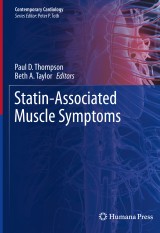Details

Statin-Associated Muscle Symptoms
Contemporary Cardiology
|
CHF 100.50 |
|
| Verlag: | Springer |
| Format: | |
| Veröffentl.: | 25.01.2020 |
| ISBN/EAN: | 9783030333041 |
| Sprache: | englisch |
Dieses eBook enthält ein Wasserzeichen.
Beschreibungen
<div><div>This book provides an overview of statin-associated muscle symptoms (SAMS) from clinical presentation to treatment and possible metabolic causes. It examines the risk factors, presentations, diagnosis and differential diagnosis, clinical management, and financial costs of SAMS. The book also highlights patients’ perspectives on SAMS such as the psychosocial, emotional, and societal factors influencing their perceptions and experiences. Finally, the book presents the results of observational and clinical trials on the prevalence of SAMS, clinical trials for treatments, and potential future research approaches for improving the understanding and treatment of SAMS.</div><div> </div><div>A key addition to the<i> Contemporary Cardiology </i>series<i>, Statin-Associated Muscle Symptoms</i> is an essential resource for physicians, medical students, residents, fellows, and allied health professionals in cardiology, endocrinology, pharmacotherapy, primary care, and health promotion and disease prevention.</div><div><br></div></div>
Chapter 1. Introduction.- Chapter 2. Do Statin-Associated Muscle Symptoms (SAMS) Exist?.- Chapter 3. The Clinical Presentation of SAMS.- Chapter 4. Definitions of SAMS.- Chapter 5. The Patient’s Perspective of SAMS.- Chapter 6. Psychosocial, Emotional, and Societal Factors Influencing Perceptions and Experiences of SAMS.- Chapter 7. Prevalence of SAMS in Observational and Clinical Trials.- Chapter 8. Risk factors for SAMS.- Chapter 9. Clinical Trials of Treatments for SAMS.- Chapter 10. Clinical Management of SAMS.- Chapter 11. Effects of Statins on Exercise Performance and Exercise Training.- Chapter 12. Genetic Risk Factors for SAMS.- Chapter 13. The Role of the Mitochondria in SAMS.- Chapter 14. The Role of Energy Metabolism in SAMS.- Chapter 15. Vitamin D and SAMS.- Chapter 16. Coenzyme Q 10 and SAMS.- Chapter 17. Diagnosing SAMS.- Chapter 18. The Clinical and Financial Cost of SAMS.- Chapter19. The Interaction of Statins and Inherited Muscle Disease.- Chapter 20. The Differential Diagnosis of SAMS.- Chapter 21. Statin-Associated Inflammatory Myositis and Other Inflammatory Conditions.- Chapter 22. Managing Statin Rhabdomyolysis.- Chapter 23. Future Directions: Critical Questions and Research Approaches to Improving Understanding and Treatment of SAMS.
<div>Paul D. Thompson, MD</div><div>Chief of Cardiology Emeritus</div><div>Hartford Hospital</div><div>Hartford, CT</div><div>Professor of Medicine</div><div>University of Connecticut School of Medicine</div><div>Farmington, CT</div><div> </div><div>Beth A. Taylor, PhD</div><div>Division of Cardiology</div><div>Hartford Hospital</div><div>Hartford, CT</div><div>Department of Kinesiology</div><div>University of Connecticut</div><div>Storrs, CT</div><div> </div><div><br></div>
This book provides an overview of statin-associated muscle symptoms (SAMS) from clinical presentation to treatment and possible metabolic causes. It examines the risk factors, presentations, diagnosis and differential diagnosis, clinical management, and financial costs of SAMS. The book also highlights patients’ perspectives on SAMS such as the psychosocial, emotional, and societal factors influencing their perceptions and experiences. Finally, the book presents the results of observational and clinical trials on the prevalence of SAMS, clinical trials for treatments, and potential future research approaches for improving the understanding and treatment of SAMS.<div> </div><div>A key addition to the<i> Contemporary Cardiology </i>series<i>, Statin-Associated Muscle Symptoms</i> is an essential resource for physicians, medical students, residents, fellows, and allied health professionals in cardiology, endocrinology, pharmacotherapy, primary care, and health promotion and disease prevention.</div><div><br></div>
Examines both sides of the debate on whether statin-related muscle symptoms exist Discusses risk factors, diagnosis and differential diagnosis, clinical presentations, and management Highlights the psychosocial, emotional, and societal factors influencing patients’ perceptions and experiences of SAMS Presents the results of observational and clinical trials on the prevalence and treatment of SAMS
Diese Produkte könnten Sie auch interessieren:

Razum prestupnika i logika prestupleniya. O psihiatrii, sudah i seriynyh ubiytsah

von: Shohom Das, Dmitry Chepusov

CHF 7.00

















